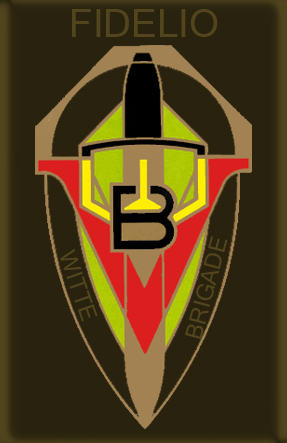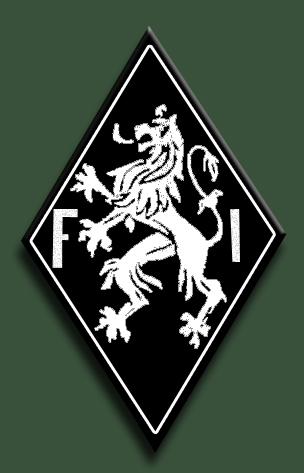|
Witte Brigade
The White Brigade ( nl, Witte Brigade, french: Brigade blanche) was a Belgian resistance group, founded in the summer of 1940 in Antwerp by Marcel Louette, who was nicknamed "Fidelio". The group was originally known as "De Geuzengroep" and changed its name again after the Liberation of Belgium to Witte Brigade-Fidelio as the term "white brigade" had emerged as a generic term to describe the resistance. The name was chosen in opposition to the "Black Brigade", a collaborator group led by SS-Untersturmführer Reimond Tollenaere, who was responsible for the propaganda of pro-German Flemish National League. The Witte Brigade was based in Antwerp but had smaller branches in Gent, Lier, Aalst, Brussels, Waasland, Wallonia and in the coastal region. Activities During the Second World War Belgium was occupied by Germany. While the fascist group known as the Black Brigade were collaborators with the Germans, they were opposed by the underground ''Witte Brigade''. Important activiti ... [...More Info...] [...Related Items...] OR: [Wikipedia] [Google] [Baidu] |
Belgian Resistance
The Belgian Resistance (french: Résistance belge, nl, Belgisch verzet) collectively refers to the resistance movements opposed to the German occupation of Belgium during World War II. Within Belgium, resistance was fragmented between many separate organizations, divided by region and political stances. The resistance included both men and women from both Walloon and Flemish parts of the country. Aside from sabotage of military infrastructure in the country and assassinations of collaborators, these groups also published large numbers of underground newspapers, gathered intelligence and maintained various escape networks that helped Allied airmen trapped behind enemy lines escape from German-occupied Europe. During the war, it is estimated that approximately five percent of the national population were involved in some form of resistance activity, while some estimates put the number of resistance members killed at over 19,000; roughly 25 percent of its "active" members.Henri B ... [...More Info...] [...Related Items...] OR: [Wikipedia] [Google] [Baidu] |
Waasland
The Waasland is a Belgian region. It is part of the Belgian provinces of East Flanders and Antwerp. The other borders of the Land van Waas are with the Scheldt and Durme rivers. The (informal) capital and major city of the region is Sint-Niklaas. It is also called the ''Land van Waas'' (Land of Waas); Waas most likely refers to the soggy soil of the region although the exact etymology is unknown. One possibility is a connection to the English word "wasteland". The swamps that characterized it have long been drained although many fields are still noticeably convex; the result of many years of plowing the topsoil towards the center to improve drainage. Historically, on account of its waterlogged, poor soils the region was thinly populated in comparison to the rest of Belgium and agriculture was by necessity based on holder farms using innovative techniques not usually applied elsewhere even if the farmers had ready markets nearby in the cities of Ghent and Antwerp. Charles Tow ... [...More Info...] [...Related Items...] OR: [Wikipedia] [Google] [Baidu] |
Mouvement National Royaliste
The National Royalist Movement (french: Mouvement national royaliste or MNR, nl, Nationale Koninklijke Beweging, NKB) was a group within the Belgian Resistance in German-occupied Belgium during World War II. It was active chiefly in Brussels and Flanders and was the most politically right-wing of the major Belgian resistance groups. Background The MNR was founded in German-occupied Belgium soon after the Belgian defeat of May 1940 by former members of the far-right Catholic, authoritarian Rexist Party. As an organisation, it had a strongly nationalist stance and was led by Eugène Mertens de Wilmars, a former admirer of the fascist, Leon Degrelle. The MNR wanted Belgium to become an authoritarian dictatorship under the rule of King Leopold III. In July 1941, the German occupation authorities became suspicious of the MNR and it was forced into hiding. After the arrest of Mertens de Wilmars in May 1942, it became overtly anti-German and began to engage in resistance activit ... [...More Info...] [...Related Items...] OR: [Wikipedia] [Google] [Baidu] |
Front De L'Indépendance
The Independent Front (french: Front de l'Indépendance or FI; nl, Onafhankelijkheidsfront, OF) was a left-wing faction of the Belgian Resistance in German-occupied Belgium in World War II. It was founded in March 1941 by Dr Albert Marteaux of the Communist Party of Belgium, Father André Roland, and Fernand Demany, another communist. The aim of the organisation was to unite Belgian resistance groups of all opinions and political leanings; nonetheless the only political party that was affiliated as such was the Communist Party. The FI operated a significant propaganda, social and paramilitary organization, in addition to its military and sabotage functions and operated in competition with the larger pro-government Secret Army. History Activities The FI established sabotage operations, escape routes and a false document service, and distributed 250 different underground publications. This essential part of the war, in the area of information, found a culmination of sorts in ... [...More Info...] [...Related Items...] OR: [Wikipedia] [Google] [Baidu] |
Armée Secrète (Belgium)
The Secret Army (french: Armée Secrète or AS, nl, Geheim Leger, GL) was a faction within the Belgian Resistance The Belgian Resistance (french: Résistance belge, nl, Belgisch verzet) collectively refers to the resistance movements opposed to the German occupation of Belgium during World War II. Within Belgium, resistance was fragmented between many sep ... active during the German occupation of Belgium during World War II. Founded in August 1940 as the Belgian Legion, the Secret Army changed its name on a number of occasions during its existence, adopting its final appellation in June 1944. It was the largest resistance group active in the country. The Secret Army incorporated many former officers from the defeated Belgian Army and, politically, was dominated by right-wing conservatives and monarchy of Belgium, royalists. Though relations were sometimes strained, the Secret Army enjoyed the closest relations of any large resistance movement with the Belgian government i ... [...More Info...] [...Related Items...] OR: [Wikipedia] [Google] [Baidu] |
Luxembourg
Luxembourg ( ; lb, Lëtzebuerg ; french: link=no, Luxembourg; german: link=no, Luxemburg), officially the Grand Duchy of Luxembourg, ; french: link=no, Grand-Duché de Luxembourg ; german: link=no, Großherzogtum Luxemburg is a small landlocked country in Western Europe. It borders Belgium to the west and north, Germany to the east, and France to the south. Its capital and most populous city, Luxembourg, is one of the four institutional seats of the European Union (together with Brussels, Frankfurt, and Strasbourg) and the seat of several EU institutions, notably the Court of Justice of the European Union, the highest judicial authority. Luxembourg's culture, people, and languages are highly intertwined with its French culture, French and German culture, German neighbors; while Luxembourgish is legally the only national language of the Luxembourgers, Luxembourgish people, French language, French and German language, German are also used in administrative and judicial ma ... [...More Info...] [...Related Items...] OR: [Wikipedia] [Google] [Baidu] |
Sachsenhausen Concentration Camp
Sachsenhausen () or Sachsenhausen-Oranienburg was a German Nazi concentration camp in Oranienburg, Germany, used from 1936 until April 1945, shortly before the defeat of Nazi Germany in May later that year. It mainly held political prisoners throughout World War II. Prominent prisoners included Joseph Stalin's oldest son, Yakov Dzhugashvili; assassin Herschel Grynszpan; Paul Reynaud, the penultimate Prime Minister of France; Francisco Largo Caballero, Prime Minister of the Second Spanish Republic during the Spanish Civil War; the wife and children of the Crown Prince of Bavaria; Ukrainian nationalist leader Stepan Bandera; and several enemy soldiers and political dissidents. Sachsenhausen was a labor camp, outfitted with several subcamps, a gas chamber, and a medical experimentation area. Prisoners were treated inhumanely, fed inadequately, and killed openly. After World War II, when Oranienburg was in the Soviet Occupation Zone, the structure was used by the NKVD as ... [...More Info...] [...Related Items...] OR: [Wikipedia] [Google] [Baidu] |
Deurne, Belgium
Deurne () is the second largest district of the municipality of Antwerp, Belgium, (right after the Antwerp town district) and has 80.781 inhabitants (2021). Deurne is best known for its green environment with the biggest park in Antwerp Rivierenhof. History Ancien régime Deurne was said to be the place where the Irish missionary Fredigand was abbot of Kerkelodor Abbey in the eighth century. There are indications that Deurne existed in prehistoric and Roman times but the first tangible proof of Deurne only dates back to 1185. During the Ancien régime Deurne was nothing more than part of the Eastern hinterland of Antwerp. Like many dwellings it settled on the crossroads of a river (the Schijn) and a connection route (the 'Turnhoutse baan': the road from Antwerp to Turnhout). Deurne consisted mainly of sparsely populated farmland. However, as a direct result of the increasing wealth of the Antwerp population, many aristocratic estates were erected (the so-called "Hof ... [...More Info...] [...Related Items...] OR: [Wikipedia] [Google] [Baidu] |
Pierlot IV Government
The Belgian Government in London (french: Gouvernement belge à Londres, nl, Belgische regering in Londen), also known as the Pierlot IV Government, was the government in exile of Belgium between October 1940 and September 1944 during World War II. The government was tripartite, involving ministers from the Catholic, Liberal and Labour Parties. After the invasion of Belgium by Nazi Germany in May 1940, the Belgian government, under Prime Minister Hubert Pierlot, fled first to Bordeaux in France and then to London, where it established itself as the only legitimate representation of Belgium to the Allies. Despite no longer having authority in its own country, the government administered the Belgian Congo and held negotiations with other Allied powers about post-war reconstruction. Agreements made by the government in exile during the war included the foundation of the Benelux Customs Union and Belgium's admission into the United Nations. The government also exercised influence ... [...More Info...] [...Related Items...] OR: [Wikipedia] [Google] [Baidu] |
Operation Sea Lion
Operation Sea Lion, also written as Operation Sealion (german: Unternehmen Seelöwe), was Nazi Germany's code name for the plan for an invasion of the United Kingdom during the Battle of Britain in the Second World War. Following the Battle of France, Adolf Hitler, the German Führer and Supreme Commander of the Armed Forces, hoped the British government would accept his offer to end the war, and he reluctantly considered invasion only as a last resort if all other options failed. As a precondition, Hitler specified the achievement of both air and naval superiority over the English Channel and the proposed landing sites, but the German forces did not achieve either at any point during the war, and both the German High Command and Hitler himself had serious doubts about the prospects for success. Nevertheless, both the German Army and Navy undertook a major programme of preparations for an invasion: training troops, developing specialised weapons and equipment, and modify ... [...More Info...] [...Related Items...] OR: [Wikipedia] [Google] [Baidu] |
Port Of Antwerp
The Port of Antwerp-Bruges is the port of the City of Antwerp. It is located in Flanders (Belgium), mainly in the province of Antwerp but also partially in the province of East Flanders. It is a seaport in the heart of Europe accessible to capesize ships. It is Europe’s second-largest seaport, after Rotterdam. Antwerp stands at the upper end of the tidal estuary of the Scheldt. The estuary is navigable by ships of more than 100,000 Gross Tons as far as 80 km inland. Like the Port of Hamburg, the Port of Antwerp's inland location provides a more central location in Europe than the majority of North Sea ports. Antwerp's docks are connected to the hinterland by rail, road, and river and canal waterways. As a result, the port of Antwerp has become one of Europe's largest seaports, ranking second behind Rotterdam by total freight shipped. Its international rankings vary from 11th to 20th ( AAPA). In 2012, the Port of Antwerp handled 14,220 sea trade ships (190.8 milli ... [...More Info...] [...Related Items...] OR: [Wikipedia] [Google] [Baidu] |








